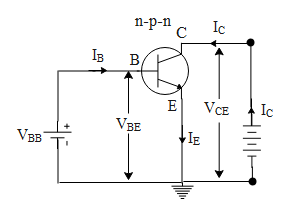
The input characteristics of a transistor in CE mode is the graph obtained by plotting
a) ${{I}_{B}}$ against ${{V}_{BE}}$ at constant ${{V}_{CE}}$
b) ${{I}_{B}}$ against ${{V}_{CE}}$ at constant ${{V}_{BE}}$
c) ${{I}_{B}}$ against ${{I}_{C}}$ at constant ${{V}_{CE}}$
d) ${{I}_{V}}$ against ${{I}_{C}}$ at constant ${{V}_{BE}}$
Answer
487.8k+ views
Hint: The common emitter characteristics are the graphs drawn between voltages and currents for a transistor when its emitter is taken as a common terminal and grounded, base is the input terminal and collector is the output terminal. The input characteristics are studied by plotting the graph of the input current and the input voltage. Hence we will see For CE mode how the transistor is arranged and accordingly come to an answer of the above question.
Complete answer:

In the above diagram we can see that the n-p-n transistor is connected in common emitter configuration. There are three types of curves that are studied for the above configuration. The input characteristics , the output characteristics and transfer characteristics. The input characteristics are studied by plotting graphs showing variation of base current ${{I}_{B}}$ with base-emitter voltage ${{V}_{BE}}$ at constant collector-emitter voltage ${{V}_{CE}}$ is called the input characteristics of the transistor.
Hence from the above information we can conclude that the correct answer of the above question is option a.
So, the correct answer is “Option a”.
Note: A graph showing variation of the collector current ${{I}_{C}}$ with collector-emitter voltage ${{V}_{CE}}$ at constant base current ${{I}_{B}}$ is called the output characteristics of the transistor. Similarly, A graph showing variation of collector current ${{I}_{C}}$ with the base current ${{I}_{B}}$ at constant collector-emitter voltage ${{V}_{CE}}$ is called the transfer characteristic of the n-p-n transistor. These characteristics are studied and various applications of transistors are harnessed.
Complete answer:

In the above diagram we can see that the n-p-n transistor is connected in common emitter configuration. There are three types of curves that are studied for the above configuration. The input characteristics , the output characteristics and transfer characteristics. The input characteristics are studied by plotting graphs showing variation of base current ${{I}_{B}}$ with base-emitter voltage ${{V}_{BE}}$ at constant collector-emitter voltage ${{V}_{CE}}$ is called the input characteristics of the transistor.
Hence from the above information we can conclude that the correct answer of the above question is option a.
So, the correct answer is “Option a”.
Note: A graph showing variation of the collector current ${{I}_{C}}$ with collector-emitter voltage ${{V}_{CE}}$ at constant base current ${{I}_{B}}$ is called the output characteristics of the transistor. Similarly, A graph showing variation of collector current ${{I}_{C}}$ with the base current ${{I}_{B}}$ at constant collector-emitter voltage ${{V}_{CE}}$ is called the transfer characteristic of the n-p-n transistor. These characteristics are studied and various applications of transistors are harnessed.
Recently Updated Pages
Master Class 12 Social Science: Engaging Questions & Answers for Success

Class 12 Question and Answer - Your Ultimate Solutions Guide

Class 10 Question and Answer - Your Ultimate Solutions Guide

Master Class 10 Science: Engaging Questions & Answers for Success

Master Class 10 Maths: Engaging Questions & Answers for Success

Master Class 9 General Knowledge: Engaging Questions & Answers for Success

Trending doubts
The gas that burns in oxygen with a green flame is class 12 chemistry CBSE

The probability that a leap year will have only 52 class 12 maths CBSE

Describe the poetic devices used in the poem Aunt Jennifers class 12 english CBSE

And such too is the grandeur of the dooms We have imagined class 12 english CBSE

What does the god that failed refer to class 12 english CBSE

Which country did Danny Casey play for class 12 english CBSE




